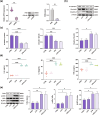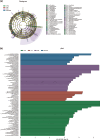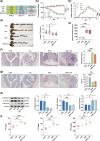Lithocholic acid ameliorates ulcerative colitis via the PXR/TLR4/NF-κB/NLRP3 signaling pathway and gut microbiota modulation
- PMID: 40905977
- PMCID: PMC12411392
- DOI: 10.1007/s00018-025-05834-2
Lithocholic acid ameliorates ulcerative colitis via the PXR/TLR4/NF-κB/NLRP3 signaling pathway and gut microbiota modulation
Abstract
Ulcerative colitis (UC) is a chronic inflammatory condition of the colon, closely linked to dysbiosis of gut microbiota and imbalances in bile acids. Lithocholic acid (LCA), a secondary bile acid, plays a crucial role in maintaining gut health; however, its specific therapeutic potential in UC remains to be fully elucidated. This study investigates the efficacy of LCA in alleviating UC and explores the underlying mechanisms, particularly focusing on the PXR/TLR4/NF-κB/NLRP3 signaling pathway and gut microbiota modulation. Using a dextran sulfate sodium (DSS)-induced colitis model, our findings demonstrate that LCA administration significantly alleviates colitis symptoms, evidenced by reduced disease activity index (DAI), increased colon length, improved intestinal barrier function, and decreased colonic inflammation. Mechanistically, LCA activates the pregnane X receptor (PXR), which inhibits TLR4-mediated NF-κB/NLRP3 inflammasome activation, leading to reduced colonic inflammation and lower levels of pro-inflammatory cytokines. Furthermore, LCA remodels gut microbiota by promoting beneficial bacterial growth, such as Akkermansiaceae, Lactobacillaceae and Muribaculaceae, while suppressing pathogenic and opportunistic pathogens, including Enterobacteriaceae and Bacteroidaceae. The gut microbiota-dependent effects of LCA were corroborated through antibiotic treatment and fecal microbiota transplantation (FMT) experiments. Notably, the absence of intestinal flora affected PXR expression and activity, modifying the aforementioned effects. Overall, our findings reveal that LCA ameliorates experimental colitis by regulating the PXR/TLR4/NF-κB/NLRP3 signaling cascade and modulating gut microbiota composition. This study underscores LCA's potential as a targeted therapeutic strategy and a promising microbiota-focused approach for managing UC, offering new insights into the role of bile acids in intestinal health and disease management.
Keywords: Gut microbiota; Lithocholic acid; NF-κB; NLRP3; Pregnane X receptor; TLR4; Ulcerative colitis.
© 2025. The Author(s).
Conflict of interest statement
Declarations. Competing interests: The authors declare no conflicts of interest. Ethical statement: All animal care and experimental procedures were approved by the Animal Research Committee of Southeast University School of Medicine (Nanjing, China) (No. 20240223001).
Figures









Similar articles
-
Gegen Qinlian decoction ameliorates TNBS-induced ulcerative colitis by regulating Th2/Th1 and Tregs/Th17 cells balance, inhibiting NLRP3 inflammasome activation and reshaping gut microbiota.J Ethnopharmacol. 2024 Jun 28;328:117956. doi: 10.1016/j.jep.2024.117956. Epub 2024 Feb 29. J Ethnopharmacol. 2024. PMID: 38428658
-
Kushenol I combats ulcerative colitis via intestinal barrier preservation and gut microbiota optimization.World J Gastroenterol. 2025 Jul 14;31(26):105656. doi: 10.3748/wjg.v31.i26.105656. World J Gastroenterol. 2025. PMID: 40678703 Free PMC article.
-
Gut microbiome promotes succinate-induced ulcerative colitis by enhancing glycolysis through SUCNR1/NF-κB signaling pathway.Am J Physiol Cell Physiol. 2025 Aug 1;329(2):C440-C454. doi: 10.1152/ajpcell.00411.2025. Epub 2025 Jun 23. Am J Physiol Cell Physiol. 2025. PMID: 40549551
-
Fucoidan as a therapeutic agent for ulcerative colitis: mechanisms of action and modulation of the gut microbiota.Front Cell Infect Microbiol. 2025 Jul 10;15:1626614. doi: 10.3389/fcimb.2025.1626614. eCollection 2025. Front Cell Infect Microbiol. 2025. PMID: 40708752 Free PMC article. Review.
-
Biomimetic nanocarriers for the therapy and management of intestinal inflammations.Int J Pharm X. 2025 Aug 21;10:100377. doi: 10.1016/j.ijpx.2025.100377. eCollection 2025 Dec. Int J Pharm X. 2025. PMID: 40919375 Free PMC article. Review.
References
-
- Le Berre C, Honap S, Peyrin-Biroulet L (2023) Ulcerative colitis. Lancet Lond Engl 402(10401):571–584. 10.1016/S0140-6736(23)00966-2 - PubMed
-
- Herauf M, Coward S, Peña-Sánchez JN et al (2024) Commentary on the epidemiology of inflammatory bowel disease in compounding prevalence nations: toward sustaining healthcare delivery. Gastroenterology 166(6):949–956. 10.1053/j.gastro.2024.02.016 - PubMed
-
- Eisenstein M (2018) Ulcerative colitis: towards remission. Nature 563(7730):S33–S33. 10.1038/d41586-018-07276-2 - PubMed
-
- Dai N, Haidar O, Askari A, Segal JP (2023) Colectomy rates in ulcerative colitis: a systematic review and meta-analysis. Dig Liver Dis 55(1):13–20. 10.1016/j.dld.2022.08.039 - PubMed
-
- Voelker R (2024) What is ulcerative colitis? JAMA 331(8):716. 10.1001/jama.2023.23814 - PubMed
MeSH terms
Substances
LinkOut - more resources
Full Text Sources
Medical
Research Materials

